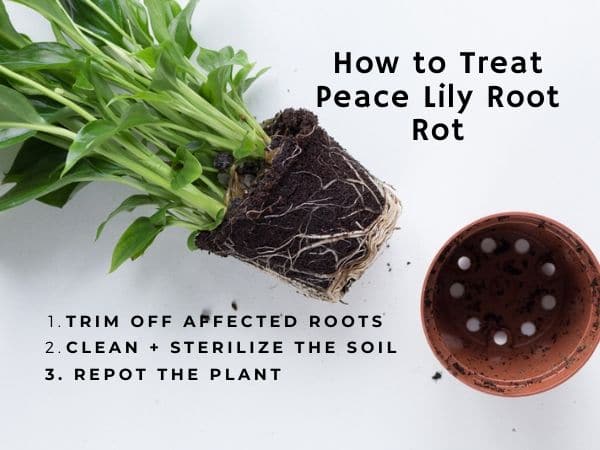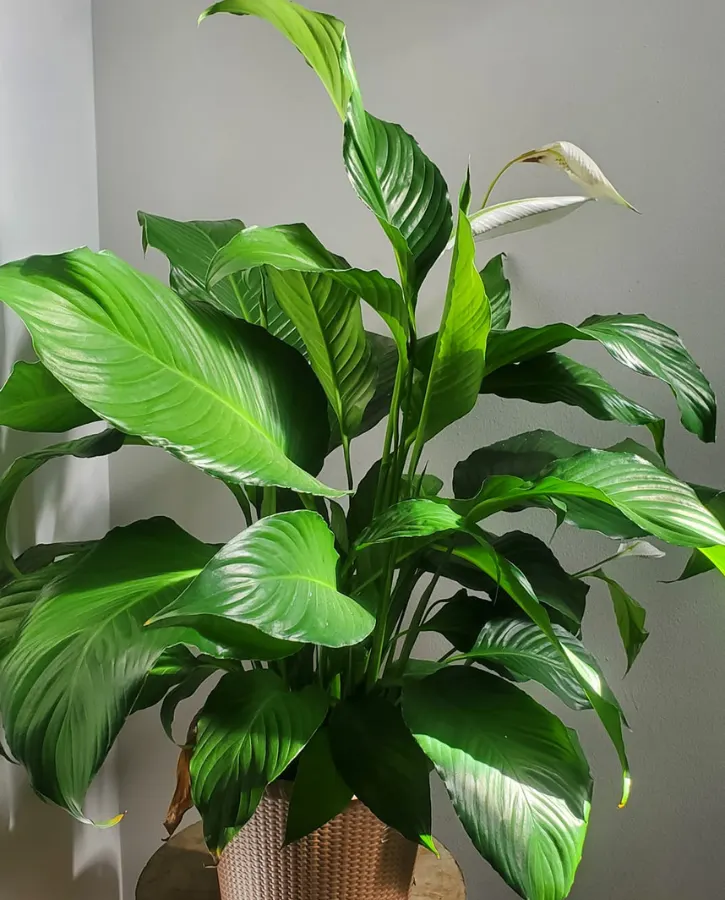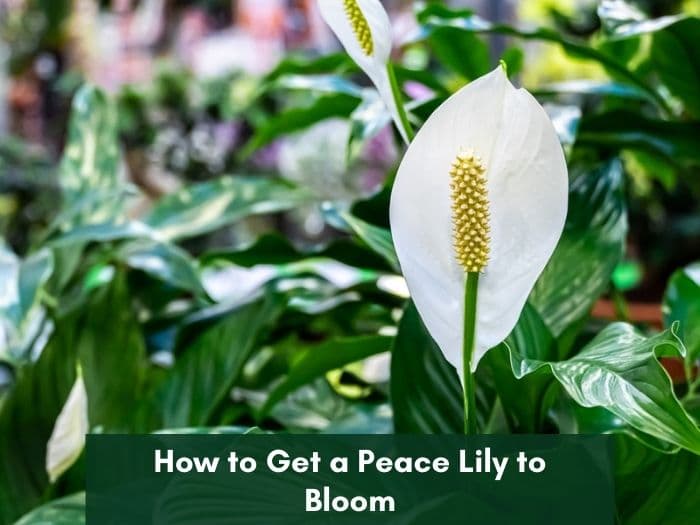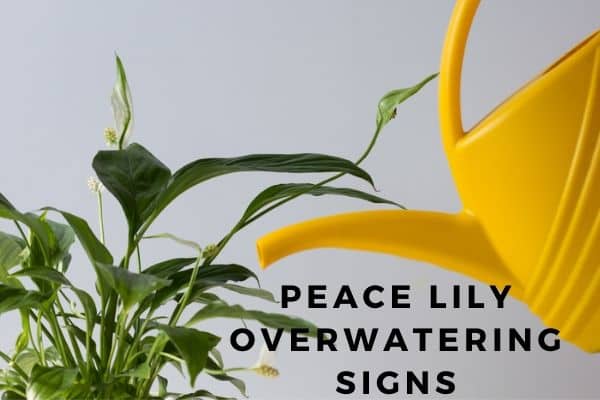Why Peace Lily Leaves Turn Brown: Causes & Fixes
I love peace lilies (Spathiphyllum spp.) for their green glossy leaves with white porcelain-colored flowers. The plant is easy to care for as it does not need much sunlight, water, or nutrients to thrive.
However, when something goes wrong, you’ll see signs such as yellowing and browning leaf tips. What causes peace lily leaves to turn brown, and how do you fix them?
The main reasons for brown peace lily leaf tips are underwatering, overwatering, overexposure to direct sunlight, high temperature, and low humidity. The plant is sensitive to water changes so, allow the soil to dry out between waterings.
Also, place it in low light and 60% humidity to fix the brown leaves.
Causes of brown leaves on peace lily
While the peace lily can thrive in the wild, it’s quite sensitive to air and soil changes. Changes in the soil lead to root rot that manifests with brown leaf tips.
Here are reasons for leaves turning brown:

1. Underwatering and overwatering
Watering problems will show signs on the foliage, with the leaves turning yellow and brown. The plant will also show drooping leaves when sitting in soggy soils. The excess water suffocates that root system making it difficult to absorb water, oxygen, and nutrients.
On the other hand, underwatering will leave your peace lily sitting in dry soil. The result is wilting due to inadequate moisture to support the plant’s cells.
Pro tip: You can check if your peace lily needs water by inserting a finger into the soil up to the second knuckle and then pulling up some soil with it.
- If you can’t roll the soil into a ball, it’s too dry.
- If you can roll the soil into a ball but can’t squeeze water from it, it’s the right amount of irrigation.
- If you can roll a ball with it but squeeze water from it, there’s too much water in it.
Best fix: Allow the soil to dry out between watering sessions to help the leaves heal and revive. The aim is to keep the soil moist rather than soggy.
2. Excess salts and fertilizers
Peace lilies need just a little fertilizer after several months. If you give it too much, the roots will burn, and the foliage will start to turn brown and die.
In addition, watering the plant with salty water will lead to brown leaf tips. The calcium in the water slowly builds up in the soil around the plant, changing the pH.
The same occurs if you use a mineral softener in water, although the buildup will be of other chemicals.
White deposits around the drain holes or the area where the soil meets the pot signify minerals and excess fertilizer.
Best fix: Drain out excess minerals by running water in the pot several times. Alternatively, repot the peace lily in a new potting mix to stop the leaves from turning brown.
3. Low humidity
Peace lilies love humid tropical conditions. When the humidity is low, the plant loses excess water to the atmosphere and ends up with crispy, dry leaf tips. Wilting is also a sign of low humidity.
Best fix: Mist your peace lily with distilled water twice a week to prevent the leaves fry drying out. Alternatively, place a plant humidifier, such as the HoneyWell Coolmist Humidifier, near your indoor plants to prevent dehydration.
4. Extreme temperatures
If you expose your peace lily to temperatures below 40°F or above 85°F for long periods, its leaf tips will start to turn brown and crispy.
Best fix: Maintain an indoor temperature of 68°F to 85°F for your peace lily. At night, it can do well with slightly cooler temperatures of 10 °F.
5. Pests and diseases and pests
Pests like spider mites can make your plants sick with bites and infections. In such a case, the plant’s leaves may start off with a gray hue, followed by brown tips.
Root rot in peace lilies is also a major cause of discoloration in foliage. In this case, the leaves will progress from yellow to brown to black, especially at the tips.
Best fix: Treat for pests and diseases. Pests can be eliminated using vinegar sprays, while root rot can be treated by repotting using a new potting mix.
6. Plant shock
At times, your peace lily may simply acclimate to the new environment and nothing more. This occurs after buying the plant, changing its watering routine, or moving it to a different part of the house.
If you transplanted the plant recently, allow it some time to acclimatize to its new pot. The brown tips will go away as the leaves drop, and new ones emerge when the plant gets proper care.
How to revive brown leaf tips
Proper care for your spathiphyllum will help revive it. However, some leaves may not recover, especially if they are damaged extensively.
That said, here are my recommendations for reviving the brown peace lily tips:
1. Water when the soil dries out
Correcting the watering routine is the first method to revive your browning peace lily. The right balance is waiting till the leaves slightly wilt, then you give it water. Another sign to know the plant needs water is when the soil dries out.
Ensure the plant’s pot has drain holes to keep the water below the root zone to avoid choking the roots.
2. Flush excess minerals out of the soil
Flush the soil in the pot by pouring a lot of clean, soft water until its drainage holes run. After that, resume the normal watering routine for the plant
Avoid applying too much fertilizer or using hard water to hydrate the plant.
Alternatively, I recommend repotting the peace lily in another pot with new, unfertilized soil. The lily may take a few days to recover, but it eventually gains new foliage.
Most peace lilies come with enough fertilizer for several months. You, therefore, don’t need to start fertilizing them right away.
3. Humidify your plant
One way of restoring the plant’s health is adding a saucer (or a wide container) with water and pebbles just under the lily’s pot. The water will evaporate and provide the needed humidity.
Also, keep your peace lily in a location without direct winds, heat vents, or fans as these blow away the moist air around the plant, causing brown leaf tips.
4. Keep temperatures between 68 and 85 °F
Avoid putting your peace lily on the balcony or directly below an air vent as it’ll be subjected to outdoor temperatures, which drop a lot during the winter.
Keep the plant where it’ll receive indirect light. Low light found in shaded areas is also good. That means keeping it close to a window facing either north or south and not in the dark.
Should I cut brown tips on peace lily leaves?
I recommend cutting off the damaged brown leaves as they won’t turn green again. Cut the old brown stalks right at the base of the peace lily at the soil line to allow new and healthy foliage to sprout.
To prune your peace lily properly, follow the brown leaf all the way to the base of the stem and then cut it off. For the leaves with very few brown sections, trim off the brown tips using sterilized scissors to prevent infecting the plant.







